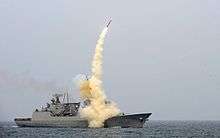Hyunmoo-3
| Hyunmoo-3 cruise missile | |
|---|---|
 Hyunmoo-3 missiles in erector launchers | |
| Type | Long-range, all-weather, cruise missile |
| Place of origin | Republic of Korea |
| Service history | |
| Used by |
Republic of Korea Army Republic of Korea Navy |
| Production history | |
| Designer |
Agency for Defense Development LIG Nex1 |
| Manufacturer | LIG Nex1 |
| Variants |
Hyunmoo-3A Hyunmoo-3B Hyunmoo-3C |
| Specifications | |
| Weight | 1.5 tons (3A)[1] |
| Length | 6 meters (19 feet) (3A)[1] |
| Warhead | Conventional: 500 kg conventional explosive |
|
| |
| Engine | turbofan[1] |
Operational range |
Hyunmoo-3A - 500 km Hyunmoo-3B - 1,000 km Hyunmoo-3C - 1,500 km |
| Speed | Mach 1.2 |
Guidance system | INS, GPS, Terrain Contour Matching[1][2] |
Hyunmoo-3 is a new cruise missile that is to be fielded with the military of Republic of Korea. It is designed by Agency for Defense Development (ADD). The name Hyunmoo (Hangul: 현무) comes from a mythical beast[2] described as the "Guardian of the Northern Sky", perhaps hinting North Korea.
Design and development
South Korea is barred from producing a non-indigenous ballistic missile that is above a certain payload and range limit in accordance to Missile Technology Control Regime. Therefore, a heavy emphasis was put on developing long-range cruise missiles by the South Korean government, as there is no restriction of payload amount and range limit set for them. With the introduction of Hyunmoo-III, which also has some advanced systems sometimes found on ICBMs, the Republic of Korea Army created the Missile Command in order to efficiently manage these missiles.
Hyunmoo-3 bears no resemblance to the previous Hyunmoo SSM, which were improved versions of Nike Hercules surface-to-air missiles that were converted into short-range high-speed surface-to-surface ballistic missiles in response to North Korea's Scud-B and Nodong-1 missile threats. Instead, the new missile's designs are strikingly similar to the United States Tomahawk cruise missile. It is powered by a turbofan engine, and has a maximum payload of 500 kilograms (1,100 lb) of conventional explosive. The guidance systems consist of Inertial guidance system and Global Positioning System.
Hyunmoo-3A, which was nicknamed "Eagle-1" (독수리-1) during the testing, has a range of 500 km, while Hyunmoo-3B, nicknamed "Eagle-2" (독수리-2), has a range of 1,000 km. Hyunmoo-3C, or "Eagle-3" (독수리-3), will be capable of striking its target up to 1,500 km away. This is a significant improvement from Hyunmoo I which had a range of 180 km and Hyunmoo-2A, which only has a range of 300 km, both of which were ballistic and not cruise missiles.
Sejong the Great class destroyers and KSS-III class submarines will be equipped with these missiles inside their Vertical Launching System (K-VLS).[1]
Uses

 Republic of Korea Army
Republic of Korea Army
 Republic of Korea Navy
Republic of Korea Navy
- Chungmugong Yi Sun-sin class destroyer (KDX-II)
- Sejong the Great class destroyer (KDX-III)
- Son Won-il class submarine (KSS-II)
- KSS-III